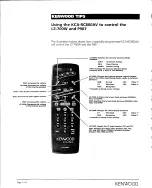
f1.mts-gruppe.com
22
EN
U
s
ing the voltage conve
rt
er
Attention!
Some external devices, particularly radios and/
or other audio devices and rechargeable devices
may not be suitable for operation via voltage
converter and could result in damage to the
connected device or the voltage converter. Please
refer to the operating instructions of the device
you wish to connect.
Immediately switch off and unplug the device if it
„buzzes“ or becomes very hot. If you are unsure
about something, please contact the retailer for
your external device.
The 230 V power socket (18), the 12 V car
socket (12) and the USB port (8) can be used
simultaneously. The total rated power of the
external devices connected to the 230 V socket,
the 12 V car socket and the USB port must not
exceed the rated power of the voltage converter
(see „Technical data“).
Note:
•
The power rating of an external device is indi-
cated on the technical label which is affixed to
the particular external device. External devices
such as electric motors, e.g. drills, electric saws,
refrigerators and music systems usually have
a greater power rating at the start up than is
specified on the technical label.
•
If the power rating is only given in Amps, simply
multiply the A value by the factor 230 to obtain
the equivalent in Watt.
•
Remember the battery pack of the device will
be discharged when operating the voltage
converter.
U
s
ing the 230 V
s
ocke
t
Only use external devices with Schuko plug or
European cable connectors.
1. Press the „220V“ button (7) to switch on the
230 V power socket (18).
2. Connect the plug of an external device to the
230 V socket (18).
3. After using the external device, disconnect the
12 V car plug from the 12 V car socket.
4. Press the „220V“ button (7) again to switch off
the 230 V power socket (18).
U
s
ing the 12 V
c
ar
s
ocke
t
1. Press the „12V“ button (1) to switch on the
12 V car socket (12).
2. Connect the plug of an external device to the
12 V car socket (12).
down for 10 minutes!
1. First read the product manufacturer‘s instruc-
tions for inflating and the approved maximum
air pressure before inflating the product.
2. Open the product‘s valve cover.
3. Attach the corresponding valve adapters to
the valve quick coupling (23) and push it into
the item’s valve. If the valve adapters comes
out of the valve whilst inflating, you will need
to push it into the valve with your hand whilst
inflating.
4. Verify the valve adapter is securely connected
to the valve by carefully pulling on it.
5. Press the „+“ (10) or „-“ button (9) until the set
value in the display (4) corresponds with the
desired pressure.
6. Set the On/Off switch (15) to „I“ to switch on
the compressor.
Note:
The compressor can be switched off at any time
by setting the On/Off switch (15) to the „O“
position.
The compressor increases the pressure according
to the set value and stops automatically.
Attention!
Observe and check the firmness of the item
whilst inflating. If the item has already been
overinflated, immediately interrupt the process
and switch the compressor off! Attention! Ex-
cessive air pressure may cause the item to burst!
Risk of personal injury and property damage!
7. Set the On/Off switch (15) to „0“ to switch off
the compressor.
8. Remove the valve adapter from the item‘s
valve and close the item‘s valve cap.
Non-binding pre
s
s
ure guideline
s
Object
Pressure
Automotive tyre
approx. 1,9 - 3,5 bar
Trailer tyre
approx. 2,4 - 3,4 bar
Motorcycle tyre
approx. 1,7 - 2,9 bar
Bicycle tyre
approx. 2,0 - 4,0 bar
Football
approx. 0,6 - 1,1 bar
Attention!
Observe the specifications of the manufacturer of
the product. Do not use the compressor to inflate
flotation devices!
















































